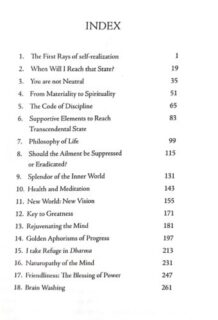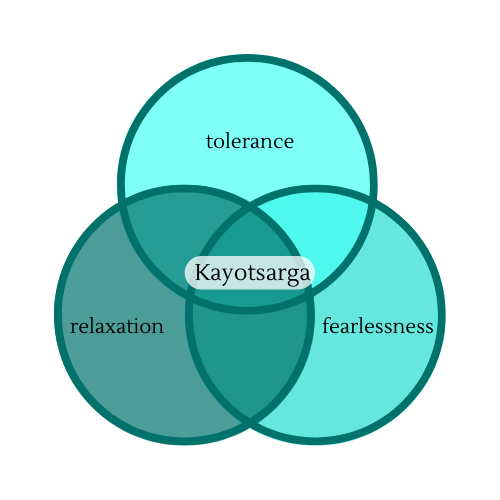
Rejuvenate Your Mind


About the Author
Being a poet along with being a philosopher is a rare combination. Acharyashri Mahapragya is a great poet besides being a great philosopher. The literature written by Acharyashri Mahapragya is proving very effective like panacea in solving the horrible problems of the present age like tension, lack of sensitivity, excitement, depression, terrorism, inferiority complex, hatred, fraud, immorality, lack of authenticity and absence of peace. In the books of Acharya Mahapragya, solutions of various problems have been given by way of experiments and training. His writings bring about an all-round development in one’s life and thus are rendering a great service to the humanity. Mankind will forever be obliged to him for his contribution that he has made through his literature.
About the Book
The book is actually based around the teachings of the book “Aaradhna” by Jacharya Ji, but in the simple and witty style of writing, characteristic to Acharya Mahapragya Ji. If I were to summarize the style of writing of this book, each chapter begins with either a short instance or question, followed by the observations and knowledge of Acharya Mahapragya Ji, which gives the reader an answer posed by the book but also makes the reader do a quick self-analysis after each chapter. Some of these interesting questions posed by the book are:
- How is the knowing of Kayotsarga necessary for knowing the Soul
- How long does it take to reach the spiritual shore?
- Are you actually Neutral in life?
- Why for vanishing of feeling of dislike, even the feeling of liking has to be relinquished?
- How no one neither completely dependent nor completely independent?
- Is there a direct approach to discipline the mind?
- How atoms of anger are bitter and atoms of compassion are sweet?
- Should the illness be suppressed or eradicated from the root?
- The choice between Emperor of external world and Emperor of the inner world.
- Is the World actually crippling or does the difference lies in the eyes of the observer?
- How the key to greatness is the perception of death
- How to revitalize the body by revitalizing the mind?
- The Golden Aphorisms of Progress
- How Aardhana is about self-analysis?
The Beginning
For one to begin on the path of finding peace and solace, a path is needed. The book too begins by first presenting the reader with a path of practice for seeking peace, i.e. kayotsarga. Kayotsarga is a practice in which one stands in a with his feet a little apart and heels close to each other in joined manner and the neck and back straight, with eyes half closed. This is the kayotsarga posture. Kayotsarga comprises further of three basic elements to practice:

The first element of tolerance means to experience the things the way they are. To let the things happen the way they are happening without worrying. Then comes in the second element of fearlessness. One might think that fearlessness means the freedom from fear of others. But actual fearlessness is the freedom from the fear born out of attachment to one’s own self. The attachment to one’s body, causes the apprehension of fear like fear of growing old, fear of getting weak, fear of death and the freedom from the attachment will result in actual fearlessness. The third and last element is relaxation, which is nothing but freedom of the body from fickleness, i.e. learning of making the voluntary nerves stable. It is with the beginning of kayotsarga practice that one can start assessing the true value of the body and experience self- realization, followed by development of equanimity.
The Practice
For one to be continuous and adamant on the path of self-realization, one has to actually answer innumerable questions which take birth from within and can also be resolved from within. These questions, sometimes even put one’s efforts, one’s entire practice and one’s patience into serious questionings for the person starts doubting if they have reached a notable milestone or not were their efforts futile. At this stage, the book every clearly explains that one needs to understand that the pit of self- realization, need not be many in number. It has been observed that one starts a practice, continues it for few months then stops it because the person thinks that no favorable result could be drawn which is a wrong procedure to follow. The truth is that one must dig one single but deep pit. This simply means that one must be tolerant and faithful in their practice and continue it, for with every single effort the pit keeps getting deeper and deeper.
It is during the practice of self- realization that one must even question their neutrality, i.e. whether their senses are neutral enough to assess a certain situation as neither good nor bad. When this neutrality is achieved for the material world, then only neutrality can be achieved for the soul. The process of neutrality automatically results in achievement of equanimity. Another practice described is the practice of detachment. However, how many of us have realized that detachment is possible only when attachment exists. When one leaves certain object, feeling of person, the mind has to find an attachment for a void has been created and in the process of spirituality, detachment is followed by attachment to the Eternal Soul, also known as the Eternal Truth. When one attaches themselves to the Eternal Soul and blindly devotes themselves to it, is then that true bliss is felt.
The book also causes a distinction between the poverty of the exterior and the poverty of the within. It has been said that when one is spiritually disconnected and have lost the path to the soul and have found solace in the material world, it is such a person who is suffering poverty from within. Even a billionaire, who is Emperor of the Materialistic World can be suffering from poverty from within and it is a bitter truth that no amount of external riches and suffice the poverty of the within. It can be sufficed only with self- introspection and by connecting to the soul.
The Solution
A very unique theory of water and fire has been described in the book which actually helps one understand that our every problem has a solution within our own selves. Similarly, even success and happiness come from within. The theory begins with the story of a kingdom engulfed in a huge fire and the King being distressed because no amount of water was able to stop the fire. The fire had taken its worst form and it seemed as if the entire kingdom would reduce to ashes. The King then went to one of his ministers for seeking help to this problem, the minister said that the fire can simply be put out if a few drops from the bath water of the Queen, Shiva Devi is used to put out the fire. The King did the same and the fire went out only with a few drops from the bath water of Queen Shiva Devi.
Similar to this, all the wild fires raging within us or around us can be put to an end because everyone has Shiva Devi within ourselves. Success does not come from outside. It is inside us. We must just unravel it. It manifests itself with little effort. Here comes in the practice of Bhavana, i.e. brain washing. It consists of repeating the same thought over and over again, until a time comes when old thoughts and believes fade away, making room for what is being repeated to establish itself. It is the practice of manifestation, through which self- transformation can be achieved.
Further, one must also have a realization of death. One chapter in the book discusses this in detail that for success one needs to be in realization of death because it is the realization of death which alone can cause the ego of the human to vanish. The way a human’s pride in their body is lost in sickness, pride in youth is lost in old age, similarly a person who is fighting death, losses ego. People who cannot envision death cannot realize their own weaknesses and flaws resulting in arrogance. In a way, it is the realization of death that a person also self- introspects their own flaws and weaknesses, which becomes absolutely necessary to avoid the evils of ego and thereby be successful.
Contact Us
Feel free to post your queries, reviews and thoughts to us by writing to us at email@anadiananth.com or by filing out the form provided in the Contact Us page.
Phone No.: 8286000868
Address: 17/2 & 3, Parvati Niwas, Juhu Village, First Floor, Sector – 11, Vashi, Navi Mumbai – 400703 Above Global Pharmacy Shop Near Main Entrance Gate and Opp Shiv Sena Shaka Near Vinamra Swaraj Hospital
@Website Owned by Adv. Lalit K Jain
@ All intellectual Property Rights and Copyright of this Website is Owned by Adv. Lalit K Jain